The Complete Beginner’s Guide to Electroacupuncture: From Fundamentals to Advanced Applications
Posted by John Hubacher on Feb 25th 2025
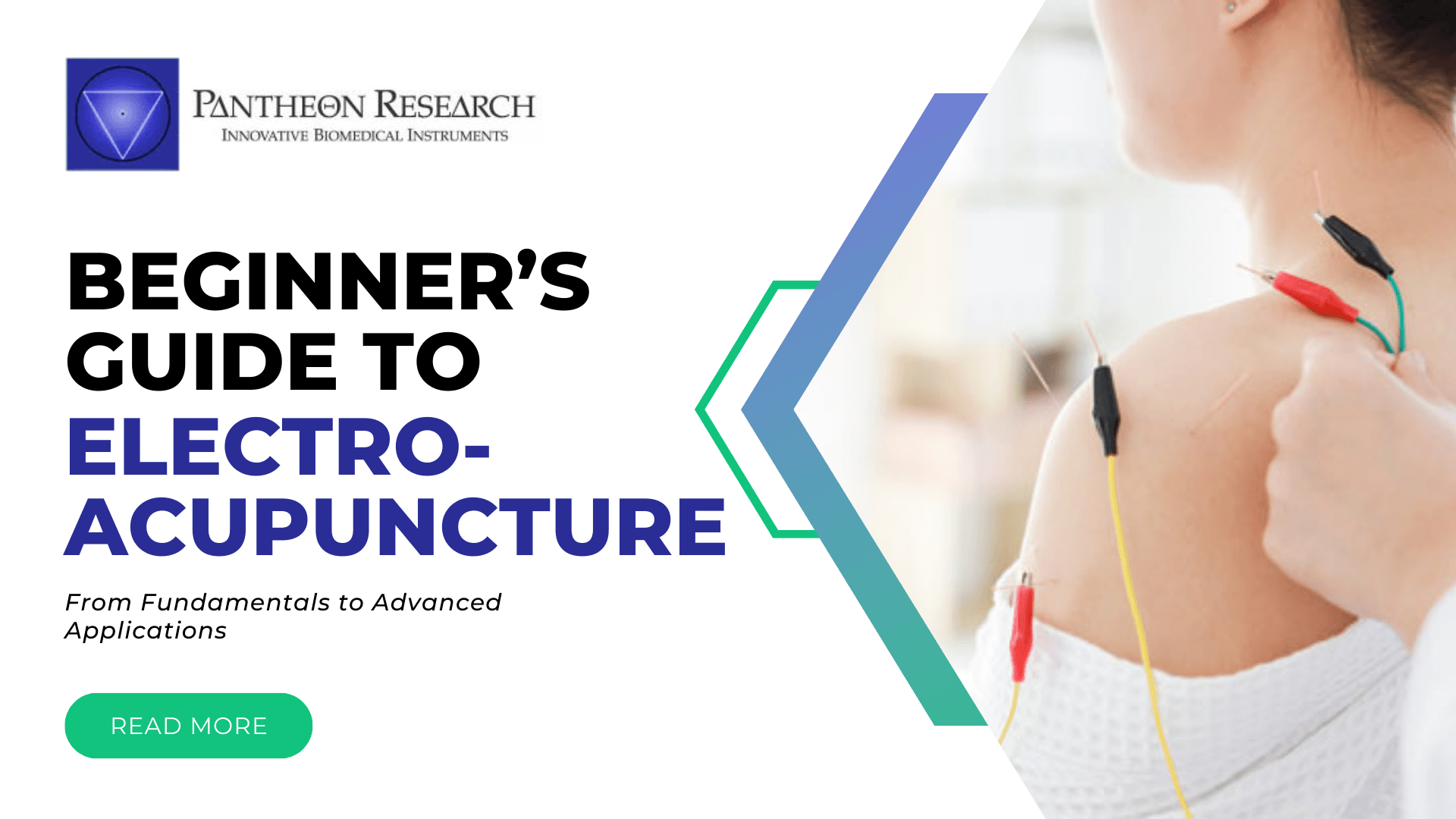
Electroacupuncture is a modern version of traditional acupuncture that uses small electrical pulses to help the body heal. So why is electroacupuncture becoming more popular? First, it’s a simple and safe way to reduce pain, improve blood flow, and help the body recover faster all without needing medicine. Plus, the electrical pulses can be adjusted to match what each person needs, making it a flexible treatment for things like sore muscles, nerve pain, and long-term aches.
But it’s not just about easing pain. Electroacupuncture also helps people feel more relaxed, lowers swelling, and improves circulation. Many doctors and therapists like it because it combines old-school healing methods with today’s science. It’s a natural way to help the body heal without worrying about the side effects of medications.
Whether you’re curious about trying a new way to feel better or you’re a healthcare professional looking to learn new skills, electroacupuncture is a powerful tool. It’s safe, effective, and helps your body heal itself with just a few tiny needles and a little electrical boost!
What is Electroacupuncture?
Electroacupuncture is a therapeutic technique that involves inserting thin, sterile needles into specific points along the body’s meridian pathways believed to carry the body's vital energy (Qi). Once inserted, gentle electrical currents are applied through the needles, stimulating nerves, muscles, and tissues.
This combination enhances the benefits of traditional acupuncture by promoting natural healing, reducing pain, and improving overall well-being. Unlike standard acupuncture, electrical stimulation allows for more consistent and controlled stimulation, making it especially effective for conditions like chronic pain, inflammation, and muscle recovery.
How Do Eastern and Western Medicine View Electroacupuncture?
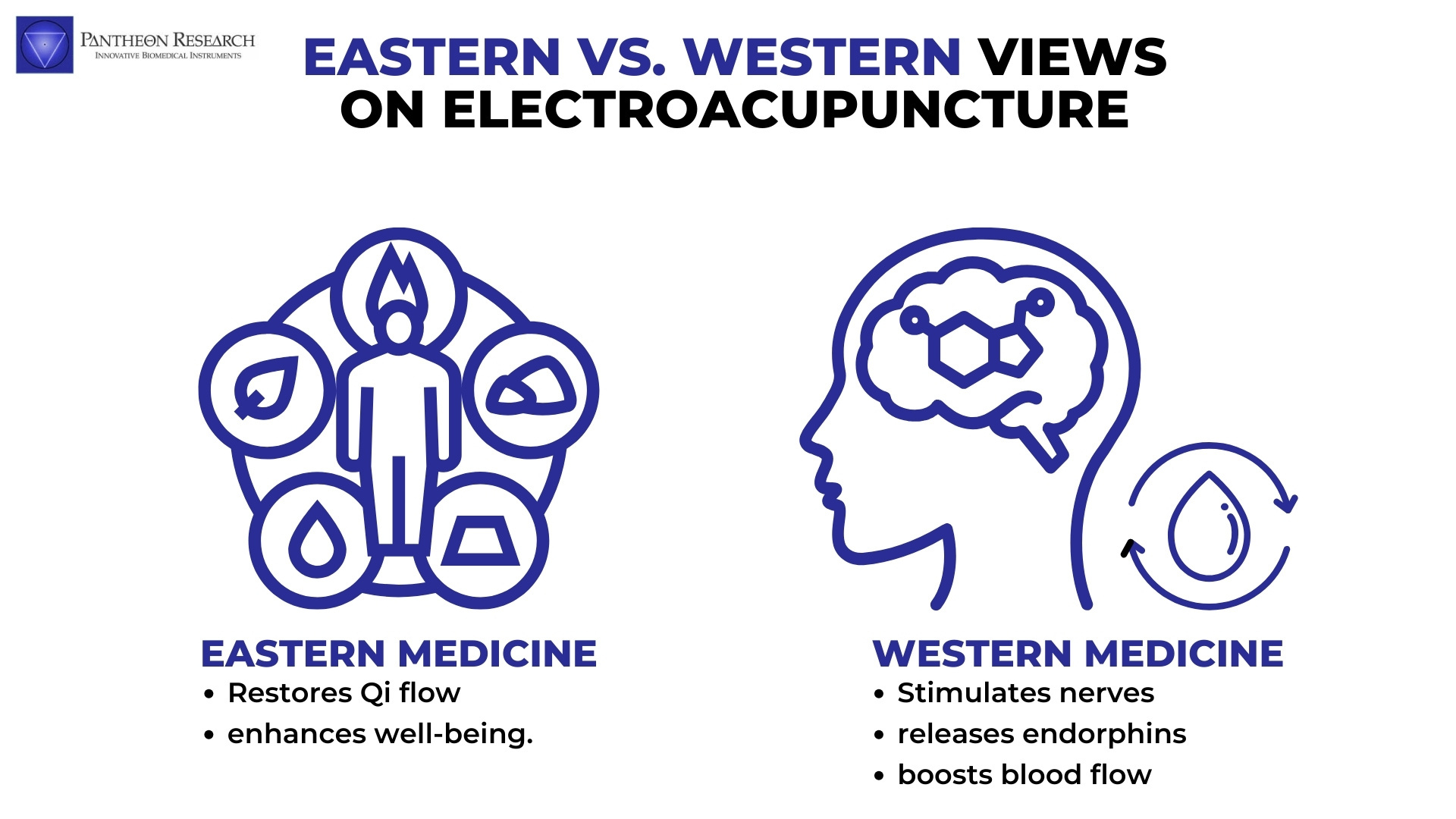
Electroacupuncture combines ideas from both Eastern and Western medicine. In Eastern medicine, it is believed to restore the flow of Qi, or energy, within the body. This helps improve overall health and well-being. In Western medicine, the treatment works by stimulating nerves, releasing endorphins (the body's natural painkillers), and increasing blood flow. Together, these effects help reduce pain, relax muscles, and speed up healing. Because it blends both approaches, electroacupuncture is used to treat many health issues, including chronic pain, muscle tension, and nerve problems.
How Electroacupuncture Works? Science and Mechanism
Electroacupuncture works by delivering controlled electrical pulses through acupuncture needles, directly stimulating the body’s nervous and muscular systems. This electrical stimulation mimics natural nerve impulses, promoting the release of endorphins, enhancing blood circulation and regulating inflammatory responses. By targeting specific acupuncture points, electroacupuncture not only alleviates pain but also improves muscle function and relaxation by influencing neural pathways.
How Electrical Stimulation Affects the Body?
When electrical currents are applied through needles, they stimulate sensory nerves, which send signals to the brain and spinal cord. This stimulation triggers the release of neurotransmitters like endorphins and serotonin, which help reduce pain and promote well-being. Additionally, electrical pulses improve blood flow, delivering oxygen and nutrients to tissues, accelerating healing & reducing inflammation.
Key Parameters: Frequency, Intensity and Waveform
The effectiveness of electroacupuncture depends on three core parameters:
-
Frequency (Hz): Determines the rate of electrical pulses delivered per second. Lower frequencies (1-10 Hz) stimulate endorphin release, helping relieve chronic pain, while higher frequencies (20-100 Hz) disrupt pain signals, making them effective for acute pain and muscle spasms.
-
Intensity (mA): Controls the strength of the electrical current. The intensity is carefully adjusted to ensure sufficient stimulation without causing discomfort, balancing therapeutic effectiveness and patient comfort.
-
Waveform: Refers to the shape of the electrical pulses, which affects how nerves and muscles respond. Continuous waveforms create steady muscle contractions, while pulsed waveforms stimulate nerves more selectively, offering tailored therapeutic effects.
Safety and Precision in Modern Electroacupuncture Devices
Modern electroacupuncture devices are designed with advanced features to ensure safety, precision and effectiveness. Accurate frequency delivery is essential, as even slight deviations can impact treatment outcomes or lead to unintended tissue responses. Modern devices include real-time monitoring and automatic shut-off systems to maintain optimal electrical parameters throughout each session. Adjustable pulse width and intensity allow practitioners to customize treatments, ensuring both safety and therapeutic effectiveness.
Essential Electroacupuncture Equipment for Beginners
To practice electroacupuncture effectively, having the right equipment is essential. Beginners should start with reliable tools that offer safety, ease of use & adjustable settings. The following components are fundamental to successful treatment:
Key Tools for Electroacupuncture
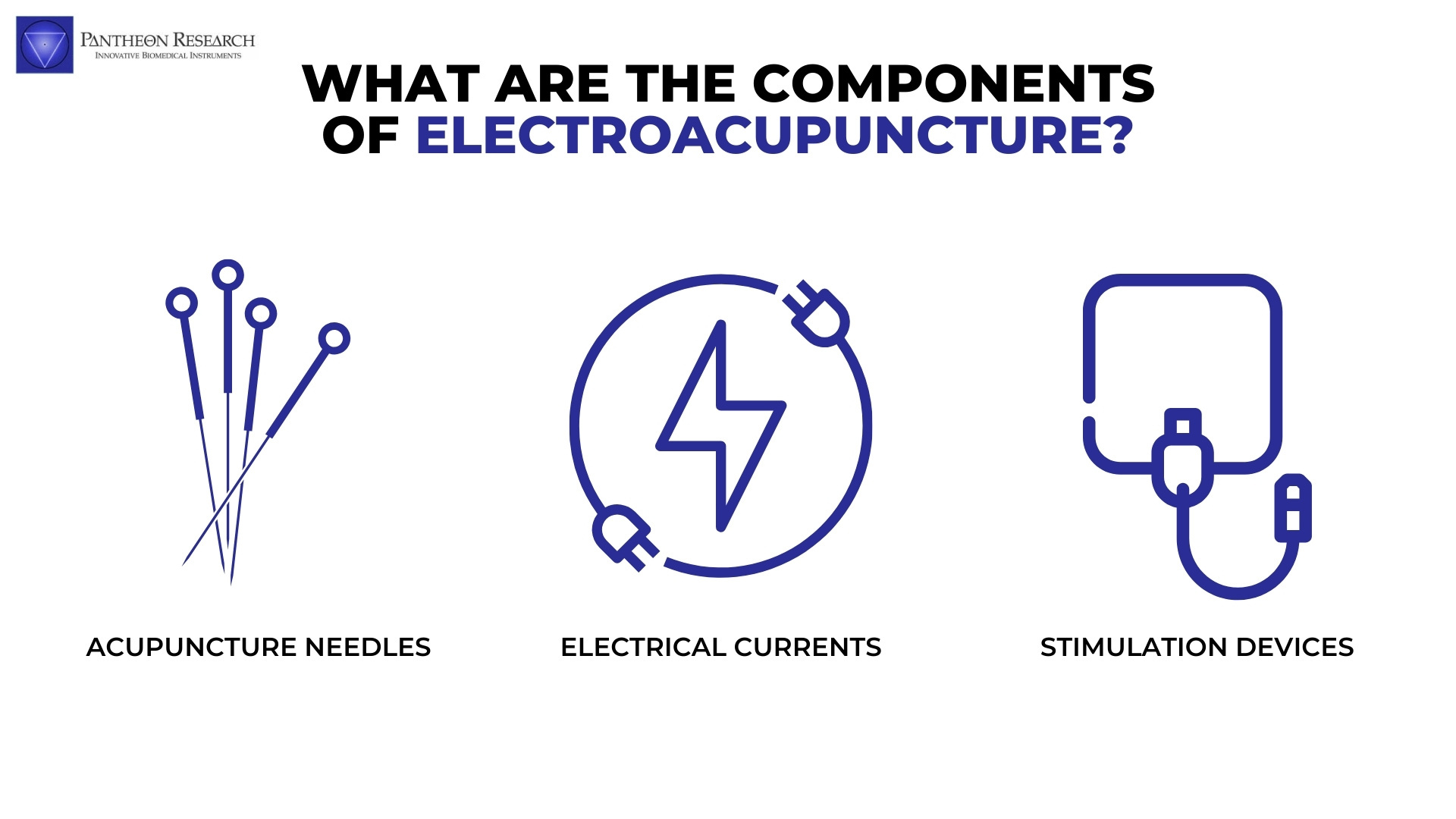
-
Acupuncture Needles: Thin, sterile and disposable needles designed specifically for electroacupuncture. These needles are inserted into acupuncture points and connected to stimulation devices using clips or leads.
-
Electrodes and Leads: Small clips or electrode leads attach to the needles, delivering electrical pulses from the stimulation device. Non-touch connectors and alligator clips are commonly used for secure and safe connections.
-
Stimulation Devices: Specialized devices regulate the electrical currents, allowing practitioners to adjust frequency, intensity & pulse width to suit each patient's needs.
Choosing the Right Electroacupuncture Device
Selecting the right electroacupuncture device ensures that treatments are safe, effective and comfortable for patients. Devices with adjustable settings allow practitioners to tailor treatments to each individual's needs, enhancing therapeutic outcomes while minimizing discomfort. Reliable tools with accurate frequency delivery and advanced safety features help build confidence, especially for beginners learning the techniques of electroacupuncture.
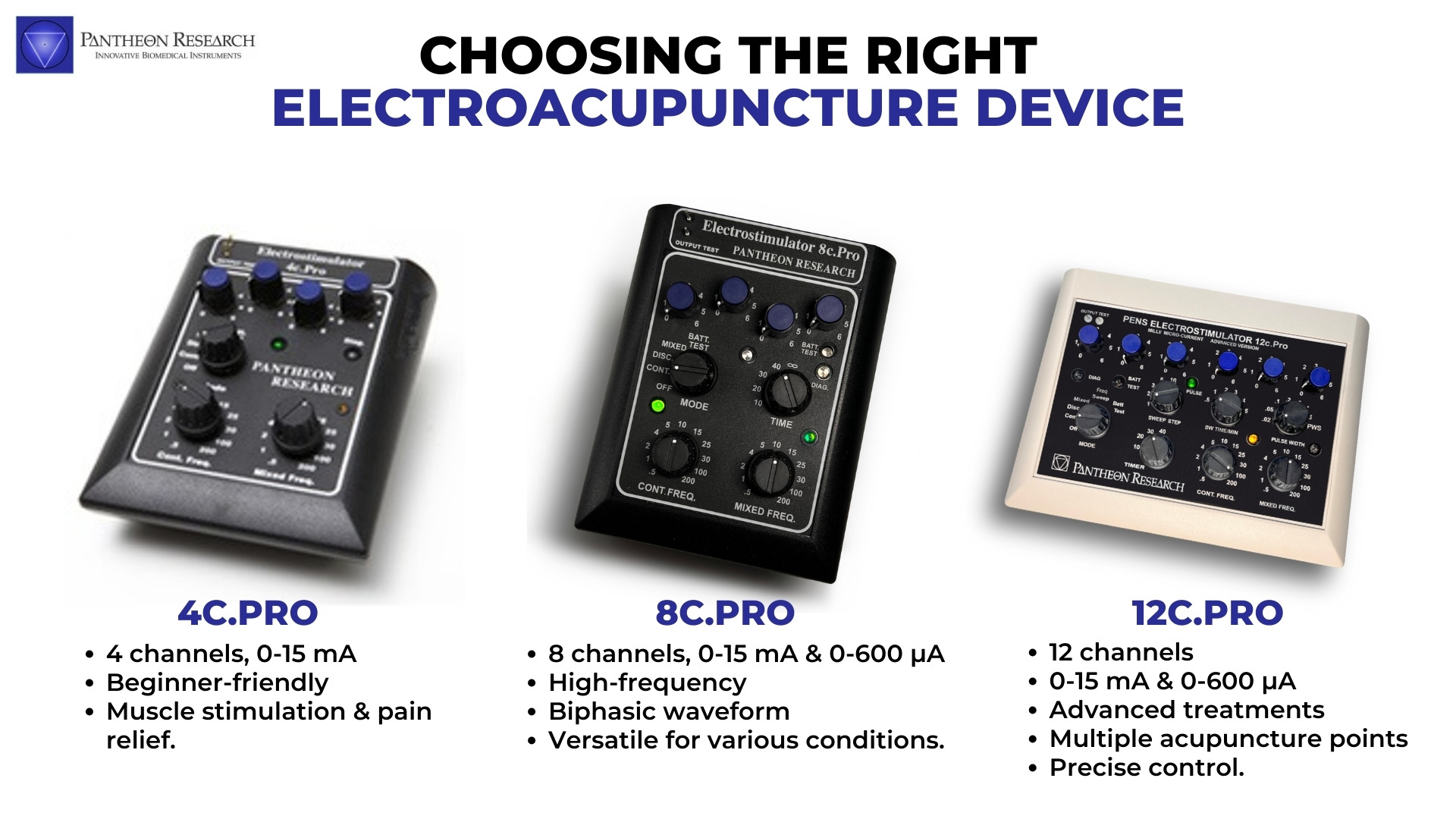
For beginners, devices with user-friendly interfaces and essential features are recommended:
-
4c.Pro: A compact device with four channels delivering milliampere currents (0-15 mA). Simple controls and built-in safety features makes 4Pro ideal for beginners focusing on muscle stimulation and pain relief.
-
8c.Pro: Featuring eight channels with both milliampere (0-15 mA) and microcurrent (0-600 µA) options, this device offers greater versatility for practitioners treating a wider range of conditions. 8pro includes high-frequency options and a symmetrical biphasic waveform for optimal therapeutic effects.
-
12c.Pro: With twelve channels divided equally between milliampere (0-15 mA) and microcurrent (0-600 µA), 12C.Pro Advanced device is designed for advanced treatments, allowing practitioners to stimulate multiple acupuncture points simultaneously. Its precise frequency control and built-in clip lead tester ensure accurate and safe treatments.
Each device is frequency calibrated to an accuracy of 99.94%, ensuring consistent and reliable stimulation. Additionally, built-in safety features such as the no-shock start function, automatic battery indicators and clip lead testers provide added confidence during treatments.
To further support practitioners, comprehensive training programs are available:
-
Electro-Acupuncture Training: These programs are specifically created for beginner and advanced acupuncturists, offering evidence-based electro-acupuncture prescriptions and a deeper understanding of the neuroscience of acupuncture.
-
Microcurrent Therapy Training: This training provides insights into microcurrent therapy applications, including facial rejuvenation and pain management, suitable for both estheticians and acupuncturists.
Step-by-Step Guide to Performing Electroacupuncture
Performing electroacupuncture requires careful preparation, precise needle placement and proper use of stimulation devices. Below is a step-by-step guide to help beginners navigate the process safely and effectively.
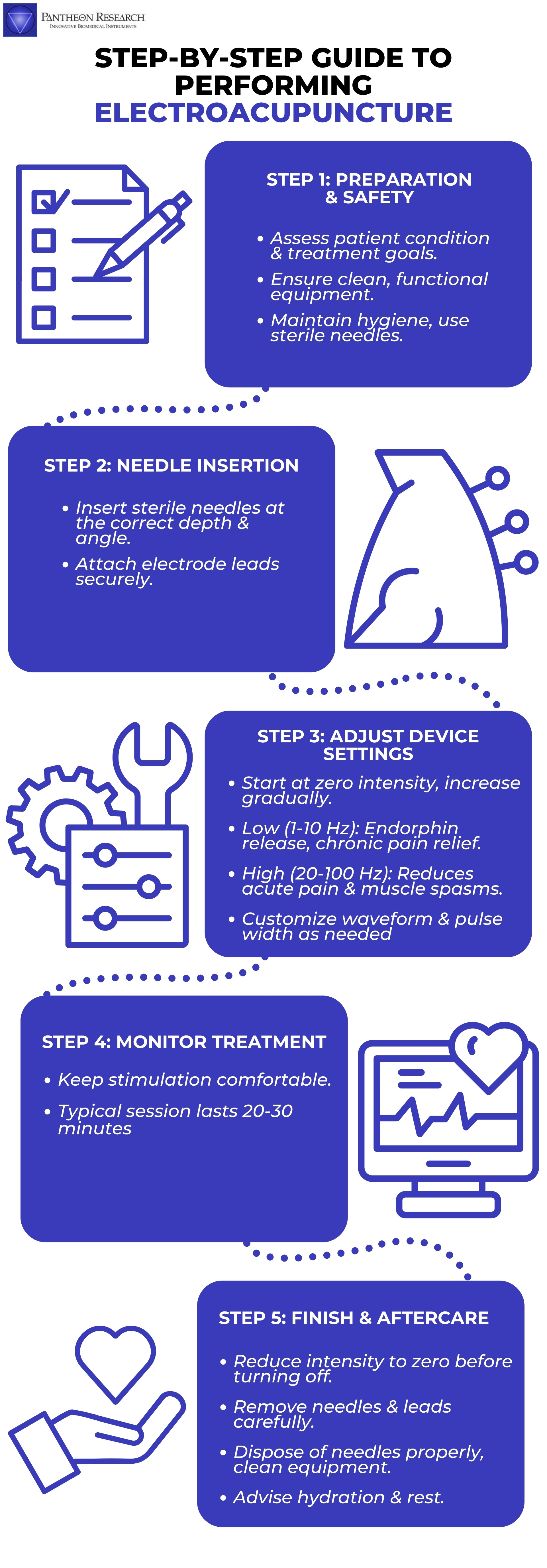
Step 1: Preparation and Safety Measures
-
Patient Assessment: Begin by assessing the patient’s condition, medical history and treatment goals. Identify the acupuncture points that will provide the best therapeutic effects.
-
Equipment Setup: Ensure that all equipment including acupuncture needles, electrode leads & electroacupuncture machines, is clean and functioning properly. Verify that the device’s batteries are fully charged or replaced as needed.
-
Hygiene and Safety: Wash your hands, wear gloves and sterilize the treatment area. Use sterile, single-use needles to prevent infection.
Step 2: Needle Insertion
-
Carefully insert fine, sterile acupuncture needles into the selected points. The depth of insertion depends on the location of the point and the patient’s body type. Ensure that the needles are inserted at the correct angle to avoid discomfort or injury.
-
Secure the electrode leads or alligator clips to the handles of the needles, ensuring a firm connection without causing the needles to move.
Step 3: Adjusting the Stimulation Device
-
Turn on the electroacupuncture device, ensuring that all output channels are initially set to zero to prevent sudden shocks.
-
Gradually increase the intensity until the patient feels a mild tingling or pulsing sensation. The intensity should be comfortable and never cause pain.
-
Adjust the frequency based on the treatment goal:
-
Low frequencies (1-10 Hz): Ideal for stimulating endorphin release and relieving chronic pain.
-
Higher frequencies (20-100 Hz): Effective for reducing acute pain and muscle spasms.
-
Customize the waveform and pulse width as needed, particularly when using devices like the PENS 12C.Pro with advanced features like Pulse Width Modulation and Sweep Function.
Step 4: Monitoring the Treatment
-
Monitor the patient throughout the session, ensuring that the electrical stimulation remains comfortable and effective.
-
Most treatments last between 20 to 30 minutes, depending on the patient’s condition and the treatment goals.
Step 5: Completing the Session
-
Slowly reduce the intensity to zero before turning off the device to avoid any sudden sensations.
-
Carefully remove the electrode leads and acupuncture needles. Dispose of the needles in a sharps container and clean the electrode leads according to the manufacturer’s instructions.
-
Provide aftercare instructions to the patient, including recommendations for hydration and rest.
What are the Benefits and Clinical Applications of Electroacupuncture?
Electroacupuncture offers a wide range of benefits by combining the principles of traditional acupuncture with the targeted stimulation of electrical currents. Its versatility makes it an effective treatment for various health conditions, particularly those involving pain, muscle dysfunction & neurological issues. Below are the key benefits and clinical applications of electroacupuncture.
Key Benefits of Electroacupuncture
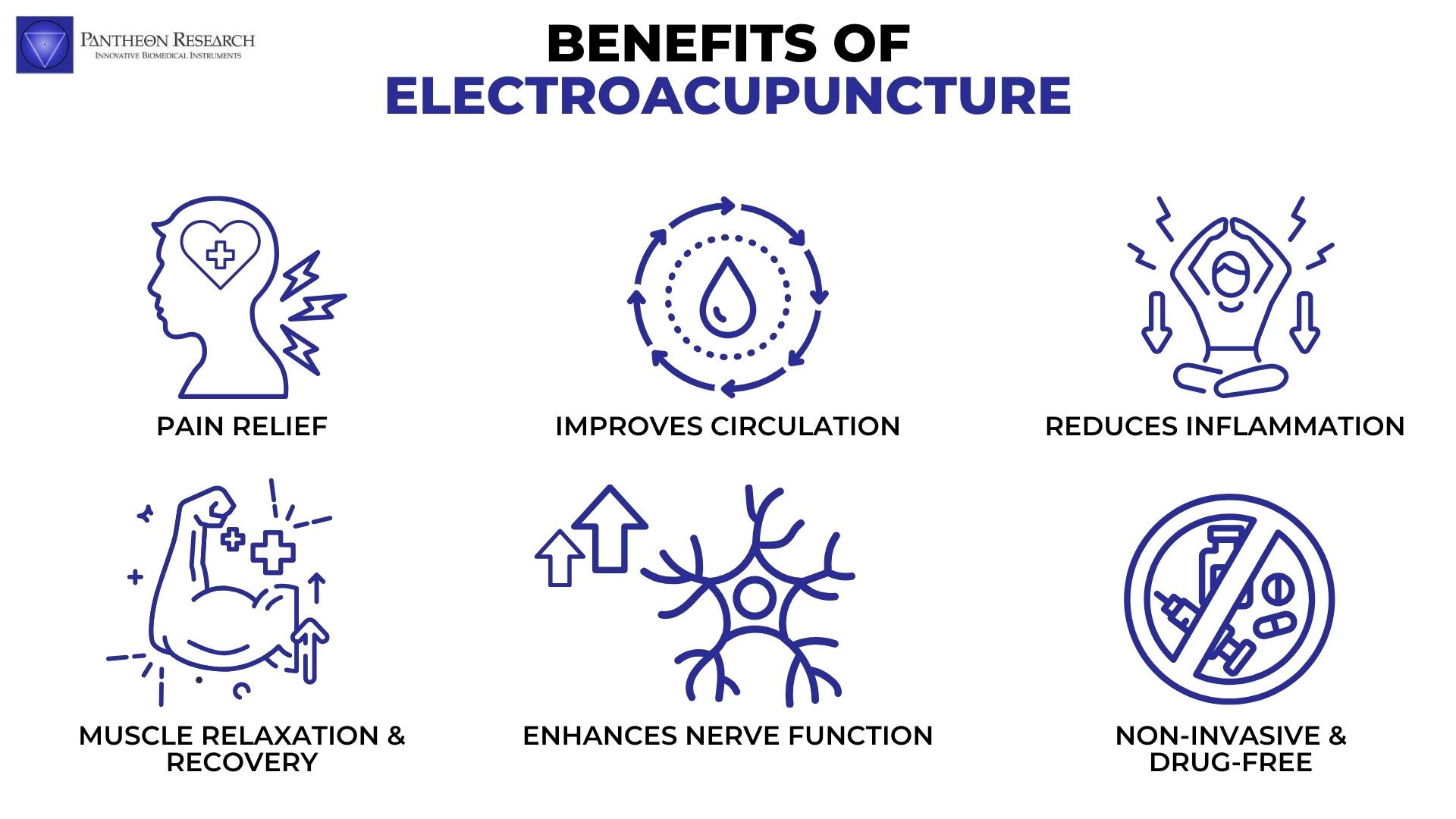
-
Pain Relief: Stimulates nerve fibers and promotes endorphin release, providing natural pain relief without medications. Studies have shown its effectiveness in reducing chronic musculoskeletal pain in cancer survivors.
-
Improved Circulation: Electrical stimulation enhances blood flow, delivering oxygen and nutrients to tissues and supporting the body’s natural healing processes.
-
Reduced Inflammation: Modulates inflammatory responses, aiding in conditions like arthritis and tendonitis. Research indicates that electroacupuncture can reduce inflammation by activating specific neural pathways.
-
Muscle Relaxation and Recovery: Low-frequency stimulation promotes muscle relaxation, while higher frequencies help relieve muscle spasms and improve muscle function. This makes electroacupuncture valuable for both rehabilitation and sports recovery.
-
Enhanced Nerve Function: By stimulating nerve pathways, electroacupuncture improves neural signaling and supports nerve regeneration, making it effective for neurological disorders and nerve damage.
-
Non-Invasive and Drug-Free: Electroacupuncture offers a natural alternative to pain medications and invasive procedures, reducing the risk of side effects and complications.
Clinical Applications of Electroacupuncture

-
Chronic Pain Conditions: Manages arthritis, lower back pain, migraines and fibromyalgia by reducing pain signals and promoting relaxation. A meta-analysis found electroacupuncture effective in alleviating chronic pain.
-
Musculoskeletal Disorders: Treats muscle spasms, tendonitis & joint stiffness by improving circulation and promoting muscle relaxation.
-
Neurological Disorders: Supports nerve regeneration and reduces symptoms of neuropathy, sciatica & stroke-related paralysis by enhancing neural signalling.
-
Sports Medicine and Rehabilitation: Accelerates recovery from sports injuries by reducing inflammation, promoting muscle repair & relieving pain.
-
Stress, Anxiety & Sleep Disorders: Stimulates the nervous system to promote relaxation, reducing anxiety, stress and insomnia. Research indicates that electroacupuncture can alleviate insomnia in patients with depression.
-
Post-Surgical Recovery: Speeds up healing and reduces pain and swelling after surgery by improving blood flow and supporting tissue regeneration.
Why Electroacupuncture Is Effective?
The success of electroacupuncture lies in its ability to provide both immediate and long-term benefits. While electrical stimulation offers quick pain relief, its effects on nerve function, circulation and inflammation support long-term healing. The precision and customization offered by modern devices ensure that treatments are tailored to each patient’s needs, enhancing their effectiveness and comfort.
Safety Guidelines and Best Practices
Ensuring safety is paramount when performing electroacupuncture. Proper techniques, equipment usage and adherence to safety protocols help maximize therapeutic benefits while minimizing risks. Below are essential guidelines and best practices for both beginners and experienced practitioners.

General Safety Guidelines
-
Patient Assessment: Always review the patient’s medical history to identify any contraindications, such as pacemakers, epilepsy, pregnancy, or heart conditions. Electroacupuncture should not be performed on individuals with these conditions unless advised by a healthcare professional.
-
Sterile Equipment: Use single-use, sterile acupuncture needles to prevent infections. Ensure that electrode leads and alligator clips are clean and well-maintained.
-
Device Setup: Before starting treatment, ensure that all stimulation devices including electroacupuncture devices and clinical microcurrent stimulators are functioning correctly. Built-in safety features, such as no-shock start functions and automatic shut-off systems, help prevent accidental shocks.
Best Practices for Safe Treatment
-
Use Devices with Built-In Safety Features: Always choose devices with automatic shut-off functions, no-shock start features and real-time monitoring for enhanced safety.
-
Start with Zero Intensity: Ensure that the device’s intensity is set to zero before turning it on, then gradually increase it to a comfortable level.
-
Avoid Sensitive Areas: Never insert needles near the eyes, throat, heart, or other sensitive areas where electrical stimulation could cause harm.
-
Monitor Patient Response: Continuously monitor the patient’s response throughout the session. Stop the treatment immediately if the patient experiences discomfort, dizziness, or unusual sensations.
Post-Treatment Care and Safety
-
Patient Aftercare: Provide the patient with aftercare instructions, including recommendations for rest, hydration & gentle stretching if needed. Advise patients to avoid strenuous activities immediately after treatment.
-
Device Maintenance: Regularly inspect and maintain electroacupuncture devices to ensure they function correctly. Replace batteries as needed and store devices in a clean, dry environment.
-
Professional Training: Practitioners should undergo proper training in both traditional acupuncture and the use of electroacupuncture devices. Beginners should practice under the supervision of an experienced practitioner until they are confident in their skills.
Contraindications and Precautions
Avoid electroacupuncture in the following situations unless explicitly advised by a healthcare professional:
-
Patients with pacemakers, defibrillators, or other implanted electronic devices.
-
Individuals with epilepsy or a history of seizures.
-
Pregnant women, especially during the first trimester.
-
Areas with open wounds, infections, or skin conditions.
-
Sensitive areas such as the head, neck, or heart region.
Conclusion
Electroacupuncture seamlessly integrates traditional acupuncture with modern electrical stimulation, offering practitioners a versatile and effective therapeutic tool. By understanding its principles, selecting appropriate equipment, adhering to safety guidelines & engaging in proper training, professionals can enhance patient outcomes across various clinical settings.
Since 1982, Pantheon Research has been at the forefront of designing and manufacturing high-quality electroacupuncture devices in the United States. With a commitment to clinical efficacy and dependability, Pantheon Research provides practitioners with reliable tools to deliver precise and effective treatments. Their dedication to innovation and quality has made them a trusted partner for professionals in the field.
For those interested in incorporating electroacupuncture into their practice, exploring Pantheon Research's range of devices and training programs can provide a solid foundation for delivering safe and effective patient care.
Frequently Asked Questions (FAQ)
1. How does electroacupuncture differ from traditional acupuncture?
Electroacupuncture enhances traditional acupuncture by applying gentle electrical currents through acupuncture needles. This additional stimulation activates nerves and muscles more effectively, promoting faster pain relief and improved healing. Unlike manual acupuncture, electroacupuncture provides consistent and adjustable stimulation, offering more precise control over treatment intensity and duration.
2. How do I select the right frequency and intensity for treatments?
The selection of frequency and intensity depends on the patient’s condition and treatment goals:
-
Frequency (Hz):
-
Low frequencies (1-10 Hz) are used for stimulating endorphin release, reducing chronic pain, and promoting relaxation.
-
Moderate frequencies (10-30 Hz) help improve blood circulation and stimulate muscle function.
-
Higher frequencies (30-100 Hz) are effective for reducing acute pain and muscle spasms.
-
Intensity (mA):
-
The intensity should be adjusted so that the patient feels a mild tingling or pulsing sensation without discomfort. The level may vary depending on the treatment area and the patient’s sensitivity.
3. How often should electroacupuncture treatments be performed?
The frequency of treatments varies based on the condition being treated:
-
For acute pain or injuries, sessions may be performed 2-3 times per week until symptoms improve.
-
For chronic conditions, weekly sessions are often sufficient to maintain long-term benefits.
-
The total number of sessions depends on the patient’s response to treatment, with many experiencing noticeable improvements within the first few sessions.
4. Can electroacupuncture help with chronic pain and nerve disorders?
Yes, electroacupuncture is highly effective for managing chronic pain conditions such as arthritis, lower back pain, and fibromyalgia. By stimulating nerve fibers and promoting the release of endorphins, it helps reduce pain and inflammation. Electroacupuncture also supports nerve regeneration and improves neural signaling, making it beneficial for conditions like neuropathy, sciatica, and stroke-related paralysis.
5. What are the potential side effects of electroacupuncture?
Side effects are rare and typically mild. Some patients may experience slight bruising, soreness, or tingling at the needle insertion sites, which usually resolves within a day or two. More serious side effects are uncommon when treatments are performed correctly by trained practitioners. Ensuring that electrical currents are adjusted to a comfortable level and using sterile needles helps minimize any risks.
6. Is electroacupuncture suitable for use in medical facilities and spas?
Yes, electroacupuncture devices are designed for use in professional settings, including acupuncture clinics, hospitals, and spas. Modern devices offer advanced features that allow practitioners to deliver precise and customizable treatments, ensuring both safety and effectiveness. Electroacupuncture is particularly valuable in rehabilitation centers and wellness spas, where it is used to relieve pain, improve muscle function and promote overall well-being.
